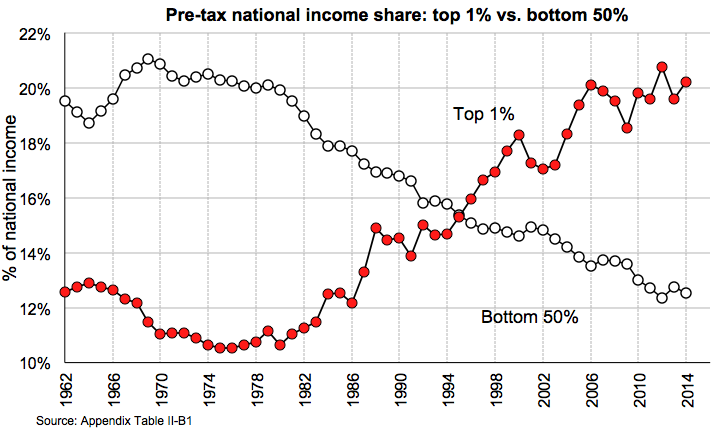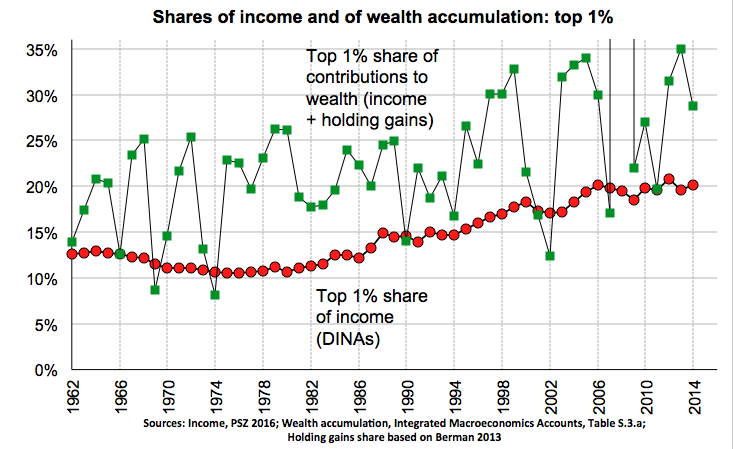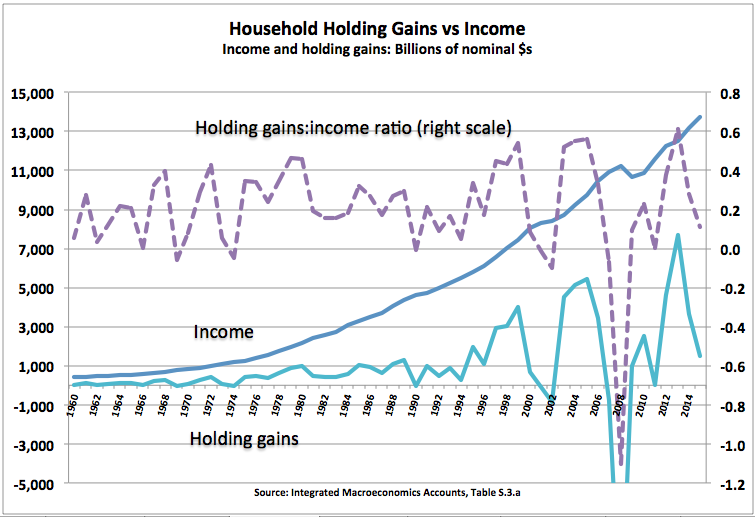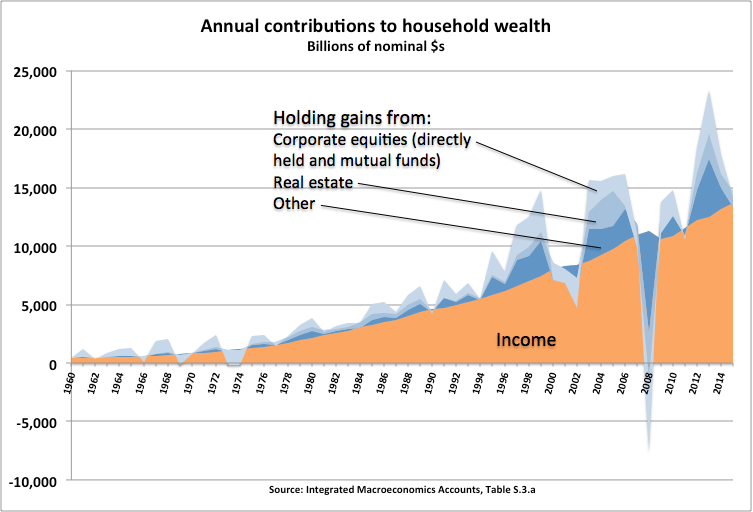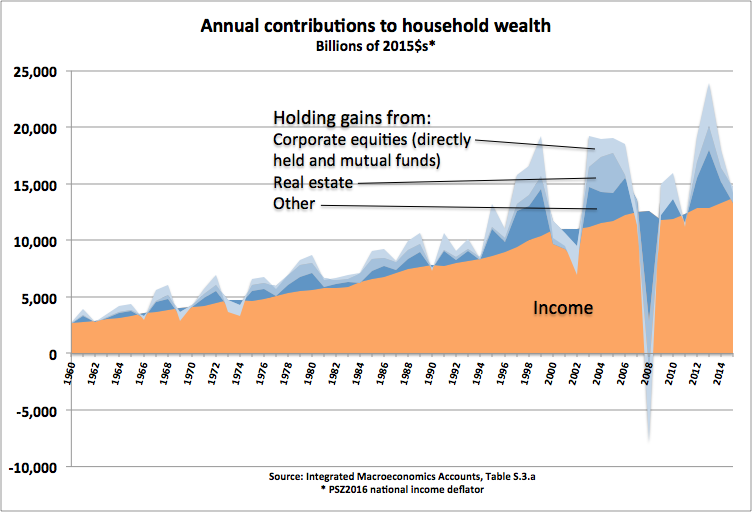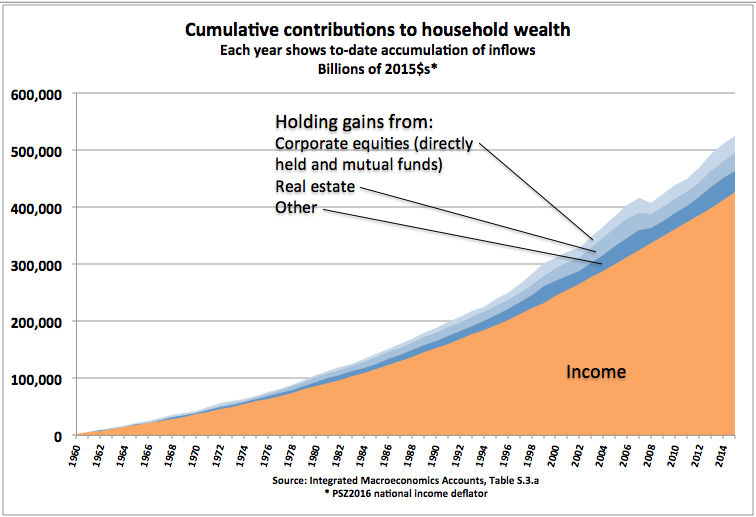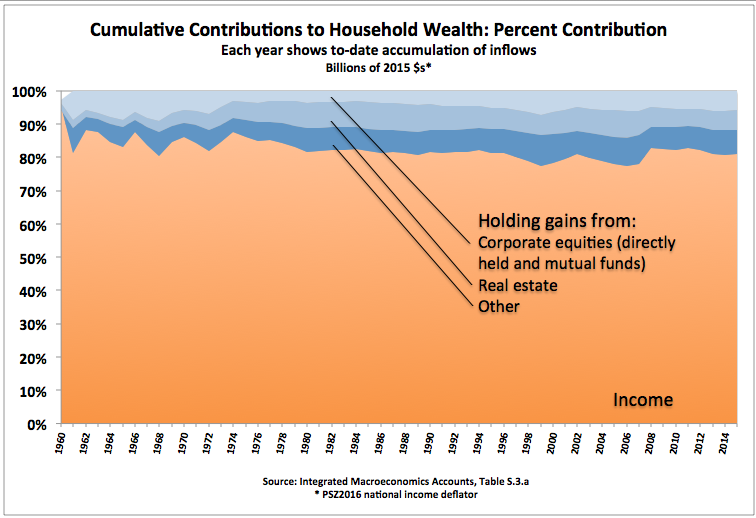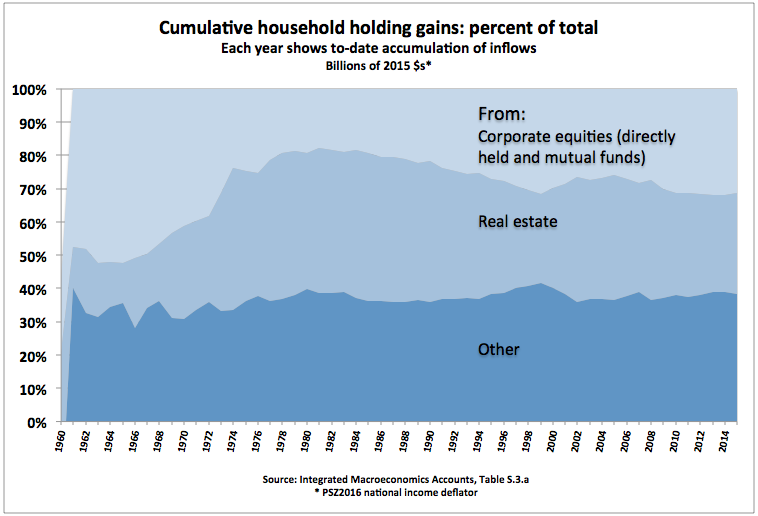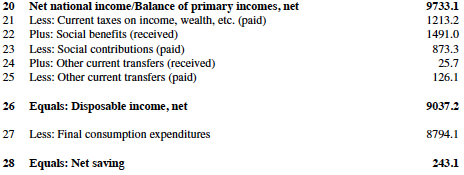On January 2 , 2017, Steve Roth writes on Economics:
It’s the American dream. A third of Americans think they’ll be rich someday. More than half of 18–29 year olds think they will be.
Less than 5% actually make it.* And many of those do it the old-fashioned way: they inherit it. About 60% of U.S. household wealth is inherited. Between a quarter and a third of Forbes 400 billionaires got rich that way. It may not be the most common way to get there, but it’s widespread, and it’s surely the easiest way.
That aspiration to wealth is deeply understandable. Getting high income from a good job is all well and good, but because wealth begets more wealth — people are compensated simply for owning things — wealth is, potentially, forever. It persists, and spreads through families and dynasties. Wealth can, and often does, endure for generations.
So it’s worth asking: how do Americans accumulate wealth? And how does that vary across income and wealth classes? How do the bottom 50% accumulate wealth, for instance, compared to the top 1%?
The Distributional National Accounts
A huge aid to answering that question arrived last month. Gabriel Zucman, Emmanuel Saez, and Thomas Piketty (PSZ) released one of the most important pieces of economic research in the last century. Their Distributional National Accounts (DINAs) reveal the distribution of national income to different income classes, wealth classes, age groups, and genders (and potentially different races, etc. etc.). This has been unavailable in the national accounts, and as a result it’s absent in most macroeconomic empirical work.
Here’s one poster exhibit:
Collect the whole set.
Zucman and company explicitly hope this distributional data “will be adopted by government agencies down the road” (see Conclusion slide). Here’s to it. The DINAs are a magisterial achievement, a treasure trove for empirical economists that merits easy access and prominent, front-and-center presentation in each release of the national accounts.
Income versus Wealth Accrual
But impressive as they are, the DINAs don’t fully answer the question of how Americans accumulate wealth. Because the DINAs only tally income, and income doesn’t include households’ holding (or “capital”) gains on stock portfolios, real estate, etc. Income does include much “property income” — dividends, interest, etc. That’s income from owning things. But it’s not everything that households receive from ownership. Holding gains figure large in that picture.
Any investor will tell you: cap [capital] gains are a big part of their wealth accumulation. Total return — dividends plus capital gains — is the measure that most savvy stock-market investors care about, long-term (and that fund managers like to tout, loudly). And much of Americans’ retirement saving — especially middle-class Americans — is accrued through capital gains on their homes.
The DINAs’ central goal is to match income as presented in the national accounts, and to reveal a multidimensional pyramid of distributional data underneath that income measure. A deeply worthy goal. But as a result, the DINAs can’t and don’t reveal the whole picture of household wealth accumulation (change in assets and net worth), or its distribution.
Here’s a rough picture of that disparity, showing a wealth-accrual measure compared to the PSZ income share, for the top one percent:**
Clearly, holding gains are much more volatile that income. But this kind of graph can still tell a long-term, secular story — and even give important insights into shorter-term trends and business cycles.
To get a feel for this: Of $22 trillion in contributions to household wealth in 2013 (income plus holding gains), the top 1% captured $8 trillion, or 35%, compared to 21% of income. That measure has exceeded 30% in eight of the last seventeen years; in the three and a half decades before 1997, it never went above 26%. (2008 is an arithmetic anomaly here, by the way. Household wealth accrual was negative that year, but one-percenters’ wealth accrual, the numerator, was even more negative.)
Concentration of total wealth accrual is almost always far higher, and has been rising faster, than concentration of income alone. The rich are getting richer, faster. It’s an inequality picture more dire even than that depicted in the DINAs. And because wealth begets more wealth, it’s a self-perpetuating picture.
We pay people for doing things, and we pay people for owning things. Increasingly, the latter.
Before expanding and detailing this picture, it’s important to say that Zucman, Piketty, and Saez are deeply aware of this reality — have discussed it many times — even though footnote 10 in their DINA working paper serves rather to obscure than reveal that understanding:
“In the long-run, a large fraction of capital gains arises from the fact that corporations retain part of their earning, which leads to share price appreciation. Since retained earnings are part of national income, these capital gains are in effect included in our series on an accrual basis. In the short run, however, most capital gains are pure asset price effects. These short-term capital gains are excluded from national income and from our series.”
Gabriel Zucman has given me permission to share his understanding of the issue, sent in private correspondence:
“You are correct that there can be pure asset valuation effects in the long run (i.e., capital gains in excess of those mechanically caused by retained earnings). These pure valuation effects are not part of national income, hence not included in our measure of income and our distributional series. However, they could be included down the road by computing income as delta wealth + consumption (i.e., Haig-Simon income). We have wealth in our database so we’re not far from being able to do this.”
Such an effort would be very welcome. (Doing so properly would require producing a reconstructed, alternate version of the DINAs calculated based on wealth accrual rather than income, from the ground up — far beyond the rough and ready estimate of one measure provided above.)
That effort would be welcome because: capital gains/losses are not just short-term fluctuations in household wealth, oscillating around some ideal book value determined by income and saving. Wealth accumulation greatly exceeds saving from income, pretty much always and everywhere, over very long periods. And holding gains are not a small part of wealth accumulation, especially for already-wealthy households.
Building the Wealth of a Nation
Below are some more pictures to get a feel for that disparity, based on the Integrated Macroeconomics Accounts (IMAs). They just show contributions to household wealth — additions to the asset side of household balance sheets. They don’t show outflows, deductions from the asset side (the primary one being consumption). Likewise, they only show “market” income — in IMA terms, “balance of primary incomes.” They don’t show nonmarket in- and outflows (mostly government taxes and transfers) that are outside of primary income.*** Holding gains are depicting the IMAs’ accrual-based, mark-to-market accounting for asset values.
2013 is is a recent anomaly here that may surprise people, worth pointing out. Households saw nominal holding gains of $8 trillion that year — equivalent to 60% of income — mostly from gains on equity shares ($3.8 trillion) and real estate ($2.2 trillion).
The share of accumulated, accrued wealth contributions attributable to previous years’ holding gains hit a high of 20% on the eve of The Great Whatever, after creeping up for decades. It dropped precipitously to 15%, and has started slowly climbing since. Absent a far more complete accounting, it’s not clear how that percentage has changed for different income and wealth classes.
Here’s the previous graph with income removed, zooming in on the proportion of holding gains received from different asset classes:
Holding gains from equities deserve some special discussion, because they’re something of a hybrid:
When firms retain earnings (profits) rather than distributing them to shareholders, the firms’ book value goes up. That increase is the firms’ net saving — think of it as firms saving on behalf of their shareholders. Stock markets certainly consider that increased book value when bidding up shares, so some portion of households’ gains on equities is arguably attributable to firms’ saving. But that portion isn’t delivered as income; households receive it as holding gains. The retained-earnings portion is hidden in those gains.
So is that portion saving from income (by firms), or holding gains (by households)? The answer is yes. It’s a floor wax and a dessert topping.
The key point here is that household holding gains on corporate equities far outstrip corporate saving, and not just over the short term. Over the last several decades those gains have delivered 31 trillion (2015) dollars onto the asset side of household balance sheets — $13 trillion more than corporations saved on households’ behalf.
So What Does it All Mean?
What’s the end result of all this wealth accumulation? I’ll point you to a somewhat outdated picture that puts across today’s massive scale of wealth inequality — far, far exceeding income inequality. Here. Be prepared to scroll.
Looking at all these pictures, you might be tempted to ask: are we just seeing a huge, many-decade, asset-price bubble? (Starting, if the nominal-dollar picture holds any meaning, with the demise of Bretton-Woods in ’71?) It’s possible that this will all revert, rather catastrophically. But I’d suggest otherwise: that we’ve actually been underestimating GDP for decades.
Coming back to our question, how Americans get and stay rich: holding gains are only one way that they get rich. But they may be the primary way that households, families, and dynasties stay rich. Because the wealthier a household is, the more it’s compensated for simply…being wealthy — for owning things, “holding” assets. (Maybe that’s why they call them households.)
That’s the kind of issue that might be well-explored with a DINA-style accounting based on wealth accrual, that includes holding gains. Here’s hoping that messieurs Piketty, Saez, and Zucman think it would be a useful effort.
On that subject, returning to one line of Gabriel Zucman’s:
“[Holding gains] could be included down the road by computing income as delta wealth + consumption (i.e., Haig-Simon income)”.
I’ll just offer one piece of advice based on years proposing and presenting exactly that: think twice about calling it “income” — even with the Haig-Simons tag attached. I’ve received almost-universal pushback on the “comprehensive income” label, even from the most enlightened (and progressive) accounting-based economists, even the proudly heterodox. (Including some at extraordinary length, and occasionally even borderline hysterical in their negativity.) PSZ may have the professional moxie to bruit the label and make it stick. But for whatever reasons — maybe just tradition and convention, but maybe the vested interests of incumbent wealthholders — people are deeply averse to any definition of “income” that includes holding gains.
Instead, call it wealth (or asset, or net worth) accumulation, or accrual, or similar. Those are arguably better labels anyway, easier for most people to understand at a glance.
———————————
* If you were in the top 5% of wealthholders in 2013, you had north of $1.9 million in net worth — not terribly rich, though you could lead a comfortable middle-class life without working (or even better than that, if you don’t have many years left to live and spend).
** This is based on 65% of capital gains going to the top 1% of income recipients — a somewhat conservative estimate according to a 2013 study (Figure 14) based on IRS data, which estimated that measure for 2010 at 85%. This percentage undoubtedly changes over time, but an authoritative time series is not available. It’s also possible, though, that 65% percent is a big overestimate. According to Edward Wolff (in private correspondence), who has studied wealth and asset shares for decades, in 2013 the top 1% of income recipients owned about 24% of household assets. If they only receive 24% of capital gains, in proportion to those holdings (a pretty big assumption), you can stop reading this article entirely; income and wealth accumulation (and change in those measures) are roughly the same. Note that the “% of assets held by” measure seems to be completely unavailable — much less a time series. Professor Wolff was only able to provide that one-year spot estimate for total assets, and PSZ have no such measure — only percent of wealth (net worth).
Bottom line: the distribution of household assets, and especially the distribution of holding gains (relative to the IMAs’ annual mark-to-market revaluation estimates), are in need of further study.
A personal note on that “big assumption” — that households’ capital gains shares are equivalent to their asset shares: I’m an investor in a private, family-held commercial property firm. Actually: in one of the firms’ SPVs or “special-purpose vehicle” LLCs, which owns two other SPV LLCs, each of which owns a middlebrow hotel. The firm quite reliably returns about 8% a year to its investors in income. But over even quite short 5- to 10-year periods, investors’ total returns (including properties’ valuation increases) run more like 16%. All to say: only a minuscule portion of the population has access to returns even vaguely in that ballpark, much less reliable returns at that level. Wondering how Donald Trump got rich(er)?
*** The calculation from household income to net saving isn’t just “income minus outflows equals saving”; there are inflows as well.
If that confuses you, join the party. It’s because (primary) income is supposed to represent market income. (And even that is reported after first deducting a significant “use” of household funds: interest payments.) Nonmarket outflows and inflows are jumbled together to derive disposable income, and consumption spending is subtracted from that to yield net saving. You could instead add the nonmarket inflows to market income, then subtract both market and nonmarket outflows, but that’s not how it’s done. Try here to see household sources and uses, inflows and outflows, tallied separately.
Steve Roth, the author of this article, fails to address that fundamentally, economic value is created through human and non-human contributions, though he does state: “We pay people for doing things, and we pay people for owning things. Increasingly, the latter. And, most importantly, what needs to be done to reform a rigged system that ensures the wealthy capital ownership class will continue to monopolize the OWNERSHIP of the future.
This refers to the two distinct, independent factors of productive contribution: human (labor) and non-human (capital) both owned by individuals.
In simple terms, binary economics recognizes that there are two independent factors of production: humans (labor workers who contribute manual, intellectual, creative and entrepreneurial work) and non-human capital (land; structures; infrastructure; tools; machines; robotics; computer processing; certain intangibles that have the characteristics of property, such as patents and trade or firm names; and the like which are owned by people individually or in association with others).
Technological change makes tools, machines, structures, and processes ever more productive while leaving human productiveness largely unchanged (our human abilities are limited by physical strength and brain power — and relatively constant). The technology industry is always changing, evolving and innovating. The result is that primary distribution through the free market economy, whose distributive principle is “to each according to his production,” delivers progressively more market-sourced income to capital owners and progressively less to workers who make their contribution through labor.
NOTE, real physical productive capital isn’t money; it is measured in money (financial capital), but it is really producing power and earning power through ownership of the non-human factor of production. Financial capital, such as stocks and bonds, is just an ownership claim on the productive power of real capital. In the law, property is the bundle of rights that determines one’s relationship to things. As binary economists Louis Kelso and Patricia Hetter put it, “Money is not a part of the visible sector of the economy; people do not consume money. Money is not a physical factor of production, but rather a yardstick for measuring economic input, economic outtake and the relative values of the real goods and services of the economic world. Money provides a method of measuring obligations, rights, powers and privileges. It provides a means whereby certain individuals can accumulate claims against others, or against the economy as a whole, or against many economies. It is a system of symbols that many economists substitute for the visible sector and its productive enterprises, goods and services, thereby losing sight of the fact that a monetary system is a part only of the invisible sector of the economy, and that its adequacy can only be measured by its effect upon the visible sector.”
The wealthy are wealthy because they OWN wealth-creating, income-producing capital assets. They are directly connected via ownership rights to real productive assets, a far less engaged in the speculative market exchanges that smaller speculators are engaged in. Note, though, millions of Americans own diluted stock value through the “stock market exchanges,” purchased with their earnings as labor workers, their stock holdings are relatively minuscule, as are their dividend payments compared to the top 10 percent of capital owners. Statistically, stock market wealth is held by a relatively small number of the most affluent. In reality, most Americans don’t have any stocks to their name. In fact, many Americans don’t even have any savings to their name. A Pew Research survey found that 53 percent of Americans say they have no money at all invested in the stock market, including retirement accounts.
According to Kelso: “The pre-tax yield of corporate assets of prosperous companies varies from 25 to 60 percent. The yield on secondhand securities is around five or six percent. Sure, with capital gains, you can get a little more, but don’t forget, that’s a zero-sum game; for every gainer, there’s a loser. Wall Street doesn’t fly any airplanes or raise any corn or do anything else in the way of producing products and services. It just plays games with your dough. And when you take it out in pensions, you’re going to get less than the company put in for you. You have to; that’s the dynamics of it.”
Roth does state: “…households’ holding (or “capital”) gains on stock portfolios, real estate, etc. Income does include much “property income” — dividends, interest, etc. That’s income from owning things. But he never distinguishes how the system perpetuates the constant concentration of capital asset ownership among the same wealthy ownership class. As stated by Roth, “because wealth begets more wealth — people are compensated simply for owning things — wealth is, potentially, forever. It persists, and spreads through families and dynasties. Wealth can, and often does, endure for generations.” This result is because the financial system is rigged to ensure that ONLY those with past savings (a denial of consumption), and thus equity collateral to pledge to secure capital credit to invest in future self-liquidating capital asset formation, will benefit via wealth accumulation. Thus, wealth is concentrating in the 1 percent because more money can be made by investing in machines and land (capital) than paying people to perform work (wages). Because capital is worth more than wages, those with an advantage to invest now in capital become the source of long-term dynasties of wealth and inequality.
Roth points to “… much of Americans’ retirement saving — especially middle-class Americans — is accrued through capital gains on their homes.” But the reality is that only approximately 62 percent of American own a home, which is really a consumption item, with a gain or loss only realized when sold.
Roth refers to retained earnings of companies: “When firms retain earnings (profits) rather than distributing them to shareholders, the firms’ book value goes up. That increase is the firms’ net saving — think of it as firms saving on behalf of their shareholders.” Retained earnings financing of new productive capital formation (reinvesting the corporate earnings already earned) is common among companies as well as debt financing. Both retained earnings and debt financing only enhance the ownership holding value of the existing corporate ownership class and do nothing to create new owners. Thus, the rich get richer systematically and capital ownership concentration is furthered, facilitated by financing further productive capital acquisition out of the earnings of existing productive capital (past savings).
The real problem is systemic monopoly ownership of the non-human factor of production. Such privileged ownership has been designed into the system, and our financial institutions are structured to continually enhance the capital wealth accumulation of the few, because the system does not free economic growth from the slavery of past savings.
Without reform we are looking at a future where there will be hordes of citizens of zero economic value. That is, unless the system can be reformed to empower EVERY citizen to acquire ownership in future wealth-creating, income-producing capital assets resulting from technological invention and innovation, without the requirement of past savings and without taking anything from those who already own.
Because productive capital is increasingly the source of the world’s economic growth it should become the source of added property ownership incomes for all. The reality is if both labor and capital are independent factors of production, and if capital’s proportionate contributions are increasing relative to that of labor, then equality of opportunity and economic justice demands that the right to property (and access to the means of acquiring and possessing property) must in justice be extended to all.
The role of physical productive capital is to do ever more of the work, which produces wealth and thus income to those who own productive capital assets. Full employment is not an objective of businesses. Companies strive to keep labor input and other costs at a minimum in order to maximize profits for the owners. They strive to minimize marginal costs, the cost of producing an additional unit of a good, product or service once a business has its fixed costs in place, in order to stay competitive with other companies racing to stay competitive through technological innovation. Reducing marginal costs enables businesses to increase profits, offer goods, products and services at a lower price (which people as consumers seek), or both. Increasingly, new technologies are enabling companies to achieve near-zero cost growth without having to hire people. Thus, private sector job creation in numbers that match the pool of people willing and able to work is constantly being eroded by physical productive capital’s ever increasing role.
People invented “tools” to reduce toil, enable otherwise impossible production, create new highly automated industries, and significantly change the way in which products and services are produced from labor intensive to capital intensive — the core function of technological invention and innovation. Kelso attributed most changes in the productive capacity of the world since the beginning of the Industrial Revolution to technological improvements in our capital assets, and a relatively diminishing proportion to human labor. Capital, in Kelso’s terms, does not “enhance” labor productivity (labor’s ability to produce economic goods). In fact, the opposite is true. It makes many forms of labor unnecessary. Because of this undeniable fact, Kelso asserted that, “free-market forces no longer establish the ‘value’ of labor. Instead, the price of labor is artificially elevated by government through minimum wage legislation, overtime laws, and collective bargaining legislation or by government employment and government subsidization of private employment solely to increase consumer income.”
Furthermore, according to Kelso, productive capital is increasingly the source of the world’s economic growth and, therefore, should become the source of added property ownership incomes for all. Kelso postulated that if both labor and capital are independent factors of production, and if capital’s proportionate contributions are increasing relative to that of labor, then equality of opportunity and economic justice demands that the right to property (and access to the means of acquiring and possessing property) must in justice be extended to all. Yet, sadly, the American people and its leaders still pretend to believe that labor is becoming more productive, and ignore the necessity to broaden personal ownership of wealth-creating, income-producing capital assets simultaneously with the growth of the economy.
In Kelso’s words, “a democratic capitalist economy is a private-property, free-market economy in which goods and services are produced through the voluntary and universal cooperation of concurrent labor workers and ‘capital workers’ [those who own the “tools] under a politically democratic government.” At present the United States economy, nor for that matter any other economy does not operate as a private-property democratic-capitalist, free-market economy. What needs to transpire is an understanding of binary economics along with instituting capital credit mechanisms that will implement the goal of broadening productive capital ownership in ways wholly compatible with the U.S. Constitution and the protection of private property.
Without a policy shift to broaden productive capital ownership simultaneously with economic growth, further development of technology and globalization will undermine the American middle class and make it impossible for more than a minority of citizens to achieve middle-class status.
As long as working people are limited by earning income solely through their labor worker wages, they will be left behind by the continued gravitation of economic bounty toward the top 1 percent of the people that the system is rigged to benefit. Working people and the middle class will continue to stagnate, resulting in a stagnated consumer economy. More troubling is that this continued stagnation will further dim the economic hopes of America’s youth, no matter what their education level. The result will have profound long-term consequences for the nation’s economic health and further limit equal earning opportunity and spread income inequality. As the need for labor decreases and the power and leverage of productive capital increases, the gap between labor workers and capital owners will increase, which will result in turmoil and upheaval, if not revolution.
Economic democracy has yet to be tried. We are absent a national discussion of where consumers earn the money to buy products and services and the nature of capital ownership, and instead argue about policies (such as a universal basic income) to redistribute income or not to redistribute income. If Americans do not demand that the contenders for the office of the presidency of the United States, the Senate, and the Congress address these issues, we will have wasted the opportunity to steer the American economy in a direction that will broaden affluence. We have adequate resources, adequate knowhow, and adequate manpower to produce general affluence for EVERY citizen, but we need as a society to properly and efficiently manage these resources while protecting and enhancing the environment so that our productive capital capability is sustainable and renewable. Such issues are the proper concern of government because of the human damage inflicted on our social fabric as well as to economic growth in which every citizen is fairly included in the American dream.
The question, as posed by Kelso is: “how are all individuals to be adequately productive when a tiny minority (capital owners) produce a major share and the vast majority (labor workers), a minor share of total goods and services,” and thus, “how do we get from a world in which the most productive factor — physical capital — is owned by a handful of people, to a world where the same factor is owned by a majority — and ultimately 100 percent — of the consumers, while respecting all the constitutional rights of present capital owners?”
I am not going to elaborate further, as I have already written extensively in other writings on my blog site at www.foreconomicjustice.org, about solutions that create universally equal opportunity for EVERY child, woman, and man be become a capital owner and put our nation on the path to inclusive prosperity, inclusive opportunity, and inclusive economic justice.
To read more about how to universally distribute economic power amongst individual citizens and never allow capital ownership to concentrate see my article “Economic Democracy And Binary Economics: Solutions For A Troubled Nation and Economy” at http://www.foreconomicjustice.org/?
Support the Capital Homestead Act (aka Economic Democracy Act) at http://www.cesj.org/learn/capital-homesteading/, http://www.cesj.org/learn/capital-homesteading/capital-homestead-act-a-plan-for-getting-ownership-income-and-power-to-every-citizen/, http://www.cesj.org/learn/capital-homesteading/capital-homestead-act-summary/ and http://www.cesj.org/learn/capital-homesteading/ch-vehicles/. See the article “The Absent Conversation: Who Should Own America?” published by The Huffington Post at http://www.huffingtonpost.com/gary-reber/who-should-own-america_b_2040592.html and by OpEd News at http://www.opednews.com/articles/THE-Absent-Conversation–by-Gary-Reber-130429-498.html.
Support Monetary Justice at http://capitalhomestead.org/page/monetary-justice.
Also see “The Path To Eradicating Poverty In America” at http://www.huffingtonpost.com/gary-reber/the-path-to-eradicating-p_b_3017072.html and “The Path To Sustainable Economic Growth” at http://www.huffingtonpost.com/gary-reber/sustainable-economic-growth_b_3141721.html. And also “Second Income Plan” at http://www.huffingtonpost.com/gary-reber/second-income-plan_b_3625319.html
Also see the article entitled “The Solution To America’s Economic Decline” at http://www.nationofchange.org/solution-america-s-economic-decline-1367588690 and “Education Is Critical To Our Future Societal Development” at http://www.nationofchange.org/education-critical-our-future-societal-development-1373556479. And also “Achieving The Green Economy” at http://www.nationofchange.org/achieving-green-economy-1373980790. Also see it complete with the footnotes at http://foreconomicjustice.org/?p=9082.
Also see “Financing Economic Growth With ‘FUTURE SAVINGS’: Solutions To Protect America From Economic Decline” at NationOfChange.org http://www.nationofchange.org/financing-future-economic-growth-future-savings-solutions-protect-america-economic-decline-137450624 and “The Income Solution To Slow Private Sector Job Growth” at http://www.nationofchange.org/income-solution-slow-private-sector-job-growth-1378041490.


